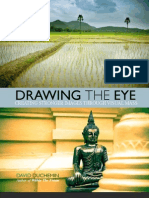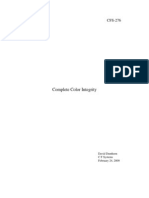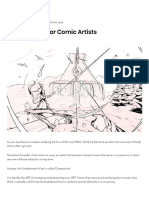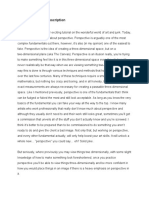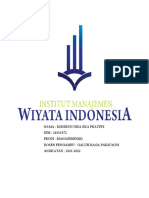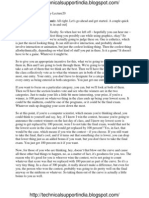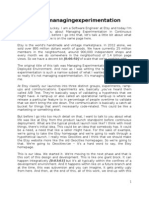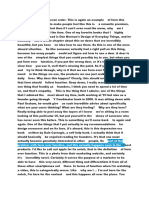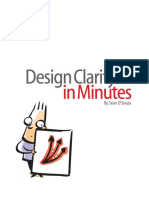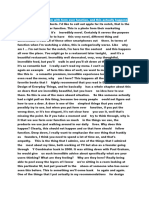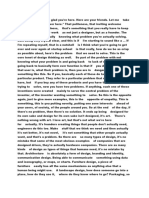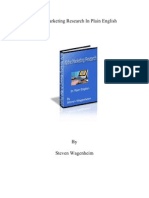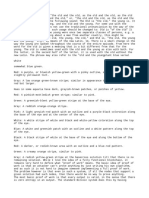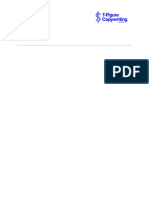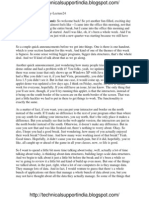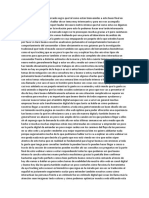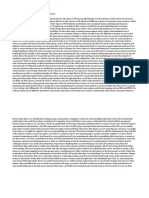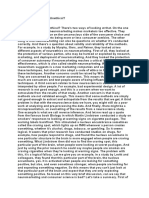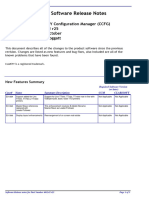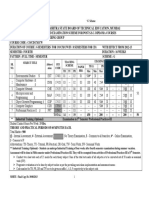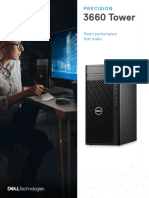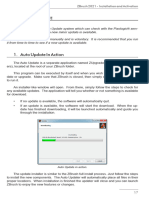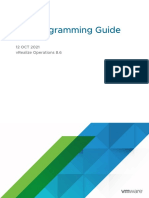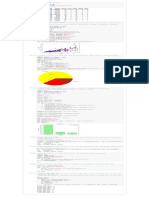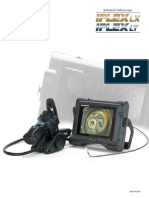0 ratings0% found this document useful (0 votes)
81 views2.3 Tools - Neurovision
2.3 Tools - Neurovision
Uploaded by
amidou diarraNeuroVision is a computational neuroscience tool that analyzes images and videos to predict where people's attention will automatically be drawn based on properties like contrast, color, and movement. The document demonstrates NeuroVision's interface by uploading sample images from online, including product shelves and packaging. The tool generates heat maps showing which areas are most salient, as well as metrics on visual complexity. Examples show how certain high-contrast products stand out more than others based on their image properties alone.
Copyright:
© All Rights Reserved
Available Formats
Download as DOCX, PDF, TXT or read online from Scribd
2.3 Tools - Neurovision
2.3 Tools - Neurovision
Uploaded by
amidou diarra0 ratings0% found this document useful (0 votes)
81 views4 pagesNeuroVision is a computational neuroscience tool that analyzes images and videos to predict where people's attention will automatically be drawn based on properties like contrast, color, and movement. The document demonstrates NeuroVision's interface by uploading sample images from online, including product shelves and packaging. The tool generates heat maps showing which areas are most salient, as well as metrics on visual complexity. Examples show how certain high-contrast products stand out more than others based on their image properties alone.
Original Title
2.3 Tools – Neurovision
Copyright
© © All Rights Reserved
Available Formats
DOCX, PDF, TXT or read online from Scribd
Share this document
Did you find this document useful?
Is this content inappropriate?
NeuroVision is a computational neuroscience tool that analyzes images and videos to predict where people's attention will automatically be drawn based on properties like contrast, color, and movement. The document demonstrates NeuroVision's interface by uploading sample images from online, including product shelves and packaging. The tool generates heat maps showing which areas are most salient, as well as metrics on visual complexity. Examples show how certain high-contrast products stand out more than others based on their image properties alone.
Copyright:
© All Rights Reserved
Available Formats
Download as DOCX, PDF, TXT or read online from Scribd
Download as docx, pdf, or txt
0 ratings0% found this document useful (0 votes)
81 views4 pages2.3 Tools - Neurovision
2.3 Tools - Neurovision
Uploaded by
amidou diarraNeuroVision is a computational neuroscience tool that analyzes images and videos to predict where people's attention will automatically be drawn based on properties like contrast, color, and movement. The document demonstrates NeuroVision's interface by uploading sample images from online, including product shelves and packaging. The tool generates heat maps showing which areas are most salient, as well as metrics on visual complexity. Examples show how certain high-contrast products stand out more than others based on their image properties alone.
Copyright:
© All Rights Reserved
Available Formats
Download as DOCX, PDF, TXT or read online from Scribd
Download as docx, pdf, or txt
You are on page 1of 4
2.
3 Tools – Neurovision
Okay, so this will be a hands-on demo of one of the computational
neuroscience tools that have appeared recently. Computational neuroscience
is a way to use computational methods, meaning making models, making
tools. Based on neuroscience, that can allow us to, better understand but also
better predict what people are going to do. And, the current tool here is
NeuroVision. NeuroVision is a tool that allows researchers to upload videos
and images and have that analyzed on the fly. Neurovision, as we have seen in
some of the other talks here, is a tool that, predicts a certain kind of attention,
the bottom-up attention perspective. So what people are automatically drawn
to, things like contrast and density and color composition. And movement are
all things that draw people's attention to them. And the thing that we will talk
about here is to show you some of the different examples, how we can use it,
and how we can interpret the results, and how we can improve the results. As
you can see the interface here it's an online dashboard. And that analyzes the
images that you will be uploading. For the purpose here, we have prepared
some images already. Just have to find them here. Let's see here. So, what we
can do is, all right, first of all we can take all the images here, but let's start
with a virtual shelf for example. We can drag and drop it over to the folder here.
It will upload, leave me a image. And for now we'll focus on images. It analyzes
that image, and in a few seconds the analysis of the image is ready. Now what
it has done is to analyze the image based on its properties, such as, as we
mentioned, density, contrast, color composition. There's no movement here,
but in movies there will be movement as well. Okay, so we can have a look at
the results. First of all, let's have a look at the basic image. I think we should
this is a retail image, so just for benchmarking the results. So what we can first
of all can see here is that you can see the store shelf here is pretty busy. You
have some things up here. You have these products, and these are all beer.
Just grab from the web. This is just an image I have taken from the web. What
witnessing here is that the visual complexity is pretty high, it's 89.2%. This is
an indication that there's a lot of things going on in the image, such as,
basically showing that there's no, or very few, blank surfaces here. There's a
lot of information, little crowding, so to speak. And that means that the
likelihood that any one item will pick up on people's attention is going to be
very low. So the, the competition for automatic attention is very high, so to
speak. Let's have a look at the heat map. Okay, so what we're going to see here
at the heat map, the hottest region here is the. Yeah, for Xs for example, what
you can see here is that there seems to be something with the contrast
between there opposition and the shelf itself. That seems to, tra, kind of trade
this huge kind of huge contrast that people are likely to spot something down
here with some other yellow and, and black sh products as well. You can also
see that the middle ones, the green ones here is the call space, let's assume is,
is not very high. You can also see the bottom here. Just, too many people may
be surprising, but if you look at shelf, it's very dark. One of the things that the
eyes are attracted very much to is dark regions. And what we can see is that
also that, people are beginning to discuss okay what, how should we design
the shelves themselves. So, here you are it is the results is, is basically
showing that there are certain products that due to the internal properties their,
their density their contrast. Their their brightness and the image for example
also the color composition and relative to their neighbors of stealing more
attention, automatic attention. They're more likely to be noticed than other
things, a different way of looking at that is by using what we call the fog map.
The fog map is just an inversion of the heat map, to illustrate what things are
going to be more likely in popping out. So you can see there the f, have fogged
out the things that are less likely to be noticed here. The saliency score here is
an indication of the complexity of the heat map. So, if you have a lot of
complexity, just a lot heat dots all, scattered everywhere, the saliency spot will
be very high. What you can see here is that there's still few, relatively few
regions showing this, this effect. When you look at the arid distribution of the
high, which is the hottest colors. The dark, dark, purpleness here, the low
which is the red to orange, the static area, which is the yellow to, especially to
the sign here. And, of course, then the neutral areas that don't attract any
attention at all, except the high region 80%, almost 20% of the images; pretty
high. So, this indicates that there are several other things that are going to
attract people's attention automatically. There will be a lot of competition for
people's attention. Now, let's turn to another analysis. And what we can look at
here. We can look at, for example, an image like this, a store like this. You can
almost, just looking at this image here, what do you believe will be the most,
the most visually appealing thing here. My guess would be these down here,
would be pretty appealing. I would guess the dress over here would be pretty
appealing as well. And there might be some things up here that, due to
contrast with the background here. Just stand out, they pop out, and probably
this dress over here as well. We'll have to see. So we upload image, we run the
analysis. The analysis only takes a few seconds and because the computer is
let's call it cloud bases system is just looking at the image. Analyze the image
and looking at what kind of. Image that we're looking at. What, what kind of
properties does it have? First of all, you can notice that the visual complexity is
much lower here. It's 28.9%. Which shows us that there are still a lot of things
going on, but not nearly as much as is in the previously example. We also see
the saliency. Keep that and the high distribution area here is very low. It's 6%
and, and 7.25% which is pretty low. It will indicate that it's not meant to be a
heat matter scattered all over the place, but it's going to focus on a few things.
Okay, so I was wrong. One thing I was right about this here. I was right about
this one up here, I didn't see this one over here and I was wrong about this one
over here. So it's a, this basically say that there are things like these things that
are popping out that people are automatically more likely to pay attention to
than other things. So this all depends on if that is what you want. If you don't
want people to have that, and you want people to look more towards this. You
have to probably do something about, about taking this away, put it away in a
different way, putting it on the side here. So it's not stealing too much
attention. The whole dictum of less is more. Is really important when it comes
to NeuroVision. And, and bottom-up attention or visual saliency is that if you
really want to have some things in the foreground, you need to fit some other
things in the background. And the foreground really illustrate that. It's probably
not showing this too well but you can see that this thing over here is going to
be intensive. This one is, is stealing a lot of attention and, of course, the dress
over here. Now, if you want to a new, one of the things that we can do [COUGH]
is to take an, look at packages for example. Just from these, from net so which
one of those are more likely to. I draw attention. I guess that would be pretty
equal but I won't be surprised there as well. And we can also at the same time
we can take [COUGH] the packaging from Coke we'll do that in a second. Let's
see here just just click the two of them right away. [NOISE] And you can upload
you can batch upload something like 15 images at a time. A video of like 30
seconds will take about seven minutes to analyze. Let's look at the coke here
first. You can see. We know that, high contrast images, are going to be more
noticed, than other ones. So, my assumption here is that the black one you can
almost see this instantly, this black one is going to just steal a lot of attention.
It's probably going to, to be almost like the winner takes all. This over here. The
question is how much will the, the information recycle. Be grabbing any
attention. Let's have another look at that. Not very much it seems. So of these,
it seems that this one takes a lot of attention. The Coke bottle also does that
pretty decently. We're not going to look at automatically at the Coca-Cola but,
you know our response to Coca-Cola is so unique. That and so strong that it's
going to be and emotional response to that anyway. So Neurovision doesn't
pre, predict emotional responses only the likelihood of people are going to
notice things in an image. You could take the other video here. Starting the
other picture here. So the question here is. So this is a product. Can you see
how the, the visual complexity is really high. It shows us there's a lot of things
going on in these packages. There's a lot of but I will also say that the images
themselves, are pretty, they're not crystal clear. That one impacts on, on the
results as well, and so the high distribution area here is really large. So it, so at
two percent it will only be a few heated areas I guess. Yes, indeed. So you can
see here this only makes up two percentage, so this is almost like the winner
takes all. Now you can see that this. Product over here will out compete the
other ones if they are put on the serve, same shelf. So the likelihood that
people are going to look at this first is very high. This doesn't take away that
the likelihood that they will the other ones will, will happen, but it's going to be
a secondary process. Again, let's go look up here. See, this is, our objects will
be the first thing that they will look at. And then finally let's see. How bout
taking. An image from today. I'm, I'm in New York City today and I what better
way of giving an example than taking a snapshot from Times Square? So let's
see. The results from minimizing the Times Square image shows us. So this is
an outdoor image. The reason we're categorizing the images is because that
we are making different benchmarks, different normative data materials for
different scenarios. So, this Neurovision can be used for testing packages as if
you're holding it in your hand. You can be testing shot packages on the
shuttles. You can be testing ads and brand positioning. And product
positioning can be tested like this outdoors to look at which signs are going to
be most appealing. My guess is it's going to be pretty obvious. This one I
guess, but I might be entirely wrong. Although I'm an expert in that doesn't
mean that I'm very good at. Predicting always what's going to be most salient.
Initial complexity is 27%, which is moderate. It shows that there is a lot of
information here. As we can see those, some, some nice dark right there, blue
skies here, so that's not going to steal a lot of attention over here. But we can
guess that. If you just look up here, the resolution actually is pretty high the
bus from here, so let's see. Yes, so the Coke image here is stealing, by far, the
most image attention. So the reason we can look at that. The reason that
happened is that, not only do we have the Coke, it's kind of the red on black.
But it also has this lines, this kind of disruptions and all this kind of angles.
And, and, one thing that, we know that the, the, the eyes are automatically
paying attention to is angles. And, and, you know, changes in, in contrast, and
changes in color and position, and the, this Coke ad is doing a very good job of
doing that. You see, it steals a lot of attention from other things. The likelihood
that people are going to see those other things is lower, at least from automatic
perspective. But if they spend a bit more time in looking around they will see
that imagery as well, but it Coke. It's by far the most dominant one. It's also, oh,
probably bit likely that they will see this sign up here as well. I don't even know
why it says your, but maybe it's a shifting thing. And the only thing, of course,
with, with Times Square is that there's a lot of movement here, and this has not
been factored into it, this analysis. If you do the video analysis I'm sure we will
see some other changes as well. So there you have it. This has been a demo of
NeurVision, a computational neuroscience tool. Which is a, kind of a hands-on
tool and a DYI, do it yourself tool for, for everyone. So, thanks for your
attention.
You might also like
- Learning How To Learn - ALLDocument77 pagesLearning How To Learn - ALLAdriana GeorgescuNo ratings yet
- Drawabox Lessons 1Document66 pagesDrawabox Lessons 1Ciccy London100% (1)
- 4.2 Case - Kirk Et Al + Ramsøy EEG, Metode EEGDocument5 pages4.2 Case - Kirk Et Al + Ramsøy EEG, Metode EEGamidou diarraNo ratings yet
- Drawing The Eye EbookDocument33 pagesDrawing The Eye Ebookshepherd99No ratings yet
- Complete Color IntegrityDocument0 pagesComplete Color Integritybungabunga19No ratings yet
- Tutorials - Episode 6 - CompositionDocument24 pagesTutorials - Episode 6 - CompositionĐăng Đại NguyễnNo ratings yet
- Composition For Comic ArtistsDocument22 pagesComposition For Comic Artistskingsleyclementakpan100% (3)
- 02-M3L2 - Our Agency Creative Process - Transcript - How To Master YouTube Ads by FoundrDocument3 pages02-M3L2 - Our Agency Creative Process - Transcript - How To Master YouTube Ads by FoundrThomas MackNo ratings yet
- STAT103 Infomation 6Document5 pagesSTAT103 Infomation 6Daphney Marie N. PepitoNo ratings yet
- Dataviz ModulesDocument16 pagesDataviz ModulesMarijanaNo ratings yet
- Tutorials - Episode 5 - PerspectiveDocument28 pagesTutorials - Episode 5 - PerspectiveĐăng Đại NguyễnNo ratings yet
- Biometrics Prof. Phalguni Gupta Department of Computer Science and Engineering Indian Institute of Technology, KanpurDocument34 pagesBiometrics Prof. Phalguni Gupta Department of Computer Science and Engineering Indian Institute of Technology, Kanpurlamba5No ratings yet
- LAW263 Test Prep 5Document4 pagesLAW263 Test Prep 5Kayla ManguladNo ratings yet
- Tugas Bahasa Inggris Khoirun Nisa Eka PratiwiDocument5 pagesTugas Bahasa Inggris Khoirun Nisa Eka PratiwiIlham RamdaniNo ratings yet
- Instructor (Mehran Sahami) : All Right. Let's Go Ahead and Get Started. A Couple QuickDocument18 pagesInstructor (Mehran Sahami) : All Right. Let's Go Ahead and Get Started. A Couple QuickNitish PathakNo ratings yet
- LAW218 Powerpoint 8Document4 pagesLAW218 Powerpoint 8emman tzhNo ratings yet
- Yousef ML Washin RegressionDocument590 pagesYousef ML Washin Regressionyousef shabanNo ratings yet
- 13 Jun ManagingexperimentationDocument10 pages13 Jun ManagingexperimentationEllaine VirayoNo ratings yet
- SOC244 Sheet 1Document2 pagesSOC244 Sheet 1Totorosé StrudelNo ratings yet
- HMT XH ZTF AesDocument14 pagesHMT XH ZTF AesNguyen Phuc MacNo ratings yet
- Creating The ContentDocument24 pagesCreating The ContentAdrian NowowiejskiNo ratings yet
- YesDocument16 pagesYesgourav.macproNo ratings yet
- MU135 Soultions 10Document5 pagesMU135 Soultions 10MurDanielNo ratings yet
- 01-Weekend Launch Party - Live RecordingDocument73 pages01-Weekend Launch Party - Live RecordingvencadigitandoNo ratings yet
- How To Shade - Liron YanconskyDocument206 pagesHow To Shade - Liron YanconskyLaurent MNo ratings yet
- EXE2Document4 pagesEXE2phongdb05No ratings yet
- Why You Can't FocusDocument6 pagesWhy You Can't FocusRayane GuendouziNo ratings yet
- Design Elements CompleteDocument18 pagesDesign Elements CompleteDaniyal AbbasNo ratings yet
- PSG Art TutorialDocument20 pagesPSG Art TutorialWalid51No ratings yet
- Med312 Study Guide 1Document3 pagesMed312 Study Guide 1Aubrey Julianna PanlilioNo ratings yet
- Foundation Project ProposalDocument12 pagesFoundation Project Proposalapi-654355042No ratings yet
- EXE2Document4 pagesEXE2phongdb05No ratings yet
- EXE2Document4 pagesEXE2phongdb05No ratings yet
- Harvard CS50 - Full Computer Science University Course - YouTube - EnglishDocument966 pagesHarvard CS50 - Full Computer Science University Course - YouTube - EnglishAli MahmoudNo ratings yet
- Niche Marketing Research in Plain EnglishDocument25 pagesNiche Marketing Research in Plain EnglishSantosh GhimireNo ratings yet
- MATH156 Assignment 9Document4 pagesMATH156 Assignment 9RioNo ratings yet
- 0 Basic Mistakes in Digital Painting and How To Fix ThemDocument52 pages0 Basic Mistakes in Digital Painting and How To Fix ThemPEDRO LUIS GARCIA GARCIANo ratings yet
- FIN240 Worksheet 9Document6 pagesFIN240 Worksheet 9Robin HexNo ratings yet
- GEO129 Analysis 2Document5 pagesGEO129 Analysis 2suhardin laodeNo ratings yet
- COMS291 Cheat Sheet 8Document3 pagesCOMS291 Cheat Sheet 8Momo JojoNo ratings yet
- GEO247 Doc 7Document5 pagesGEO247 Doc 7jijijiNo ratings yet
- Alternative Exposure SystemDocument5 pagesAlternative Exposure SystemchioqueNo ratings yet
- LAT234 Image 4Document4 pagesLAT234 Image 4FILBERT BADILLONo ratings yet
- 7FC-M1L2-Philosophy On World-Class Copy - Art + Science + Authenticity-TranscriptDocument3 pages7FC-M1L2-Philosophy On World-Class Copy - Art + Science + Authenticity-Transcriptgreet.agathaNo ratings yet
- 2 - 1 - L1-Part 1 - The Context of InnovationDocument10 pages2 - 1 - L1-Part 1 - The Context of InnovationNouman ShafiqueNo ratings yet
- Photorealistic Texturing For Dummies Pt5Document10 pagesPhotorealistic Texturing For Dummies Pt5Miroslav MojicNo ratings yet
- Instructor (Mehran Sahami) : So Welcome Back! So Yet Another Fun-Filled, Exciting DayDocument17 pagesInstructor (Mehran Sahami) : So Welcome Back! So Yet Another Fun-Filled, Exciting DayNitish PathakNo ratings yet
- Photorealistic Texturing For Dummies Pt4Document6 pagesPhotorealistic Texturing For Dummies Pt4Miroslav MojicNo ratings yet
- Daniel Coyle-The Talent Code (Unplugged)Document15 pagesDaniel Coyle-The Talent Code (Unplugged)bothecat100% (3)
- 7FC-M3L5-Video Sales Letter (VSL) Scripting-TranscriptDocument4 pages7FC-M3L5-Video Sales Letter (VSL) Scripting-Transcriptgreet.agathaNo ratings yet
- 10 Techniques That Are Essential For Successful Photo ManipulationDocument10 pages10 Techniques That Are Essential For Successful Photo ManipulationRamon D HernandezNo ratings yet
- Thinking Inside The Box A Complete EQ TutorialDocument19 pagesThinking Inside The Box A Complete EQ TutorialDanny Geiyer100% (1)
- Learn How to Draw Computer Portraits For the Beginner: Step by Step Guide to Drawing Portraits Using SAI Paint ToolFrom EverandLearn How to Draw Computer Portraits For the Beginner: Step by Step Guide to Drawing Portraits Using SAI Paint ToolNo ratings yet
- Pixel Art - Common MistakesDocument5 pagesPixel Art - Common Mistakesryder grayNo ratings yet
- Lec 102Document12 pagesLec 102KeerthiNo ratings yet
- Video 1Document12 pagesVideo 1Kerny :DNo ratings yet
- (Views4You - English - 156. Design Talks - How We Create Our World Through Communication) 156. Creative Communication - How Our Design Choices Illustrate Our ValuesDocument35 pages(Views4You - English - 156. Design Talks - How We Create Our World Through Communication) 156. Creative Communication - How Our Design Choices Illustrate Our Valueslin mouleNo ratings yet
- 1-6 - What Savoir-Relier Really IsDocument3 pages1-6 - What Savoir-Relier Really Isamidou diarraNo ratings yet
- 1.4 PET and MR ScannersDocument1 page1.4 PET and MR Scannersamidou diarraNo ratings yet
- 3.4 Interview With Per Møller Part 2Document2 pages3.4 Interview With Per Møller Part 2amidou diarraNo ratings yet
- 1.1 Hello and Welcome To This New IntroductoryDocument2 pages1.1 Hello and Welcome To This New Introductoryamidou diarraNo ratings yet
- 5.3 Interview With Richard Silberstein'Document15 pages5.3 Interview With Richard Silberstein'amidou diarraNo ratings yet
- 1.3 Case - Knutson Et Al + Pessiglione Et Al, Method fMRIDocument3 pages1.3 Case - Knutson Et Al + Pessiglione Et Al, Method fMRIamidou diarraNo ratings yet
- 6.4 Is Neuromarketing UnethicalDocument2 pages6.4 Is Neuromarketing Unethicalamidou diarraNo ratings yet
- 4.4 EEG MethodDocument3 pages4.4 EEG Methodamidou diarraNo ratings yet
- NCE-T HCIA LectureDocument95 pagesNCE-T HCIA LectureSayed Rahim NaderiNo ratings yet
- Rpa Unit2Document35 pagesRpa Unit2jiledoy752No ratings yet
- Csixrevit Version 2021.0: Notice Date: 11 November 2020Document9 pagesCsixrevit Version 2021.0: Notice Date: 11 November 2020UDDOM CHHENGNo ratings yet
- AdventureGameLocomotionSystem v1 INFO-1Document8 pagesAdventureGameLocomotionSystem v1 INFO-1rabookc2No ratings yet
- DX DiagDocument40 pagesDX DiagAbdulsalam ShNo ratings yet
- Xprinter Thermal PrinterDocument2 pagesXprinter Thermal Printerarqueano ZunguzaNo ratings yet
- NetXMS Monitoring BrochureDocument9 pagesNetXMS Monitoring Brochurekaram yousifNo ratings yet
- Videojet Software Release NotesDocument5 pagesVideojet Software Release Notesmike mikeNo ratings yet
- SCHEME - G Fourth Semester (CO, CM, CD, CW)Document38 pagesSCHEME - G Fourth Semester (CO, CM, CD, CW)Sameer GulhaneNo ratings yet
- Polyspace Bug Finder Server RefDocument524 pagesPolyspace Bug Finder Server RefLộc HuỳnhNo ratings yet
- Euphoria An It Quiz Essential Volume 2Document54 pagesEuphoria An It Quiz Essential Volume 2Garvit SwamiNo ratings yet
- Installing The ROSS 5D Client AppDocument8 pagesInstalling The ROSS 5D Client AppAlexandre TripierNo ratings yet
- You Click, I Steal: Analyzing and Detecting Click Hijacking Attacks in Web PagesDocument24 pagesYou Click, I Steal: Analyzing and Detecting Click Hijacking Attacks in Web PagesUdupiSri groupNo ratings yet
- Ch.01 Introduction To ComputersDocument11 pagesCh.01 Introduction To Computerssolomon theorideloNo ratings yet
- Precision 3660 Spec SheetDocument9 pagesPrecision 3660 Spec SheetDodi VenesiaNo ratings yet
- ZBrush 2021 Whats New Part2Document16 pagesZBrush 2021 Whats New Part2Florin StanciuNo ratings yet
- Vrealize Operations 86 Api GuideDocument30 pagesVrealize Operations 86 Api GuideJuliano PereiraNo ratings yet
- LogDocument2 pagesLogzahira2012setiawanNo ratings yet
- Import Import As Import As: CSV Numpy NP Pandas PDDocument1 pageImport Import As Import As: CSV Numpy NP Pandas PDHasan Galiv NabinNo ratings yet
- Uml PreviewDocument25 pagesUml PreviewKashif RiazNo ratings yet
- Olympus IplexDocument16 pagesOlympus IplexZaid RazabNo ratings yet
- Annexure 1.II NMHS Annual Progress Report 2019-20Document25 pagesAnnexure 1.II NMHS Annual Progress Report 2019-20Nguyễn Hoàng PhúcNo ratings yet
- Operating System Noise in The Linux KernelDocument12 pagesOperating System Noise in The Linux KernelAman PrasadNo ratings yet
- SEEnergy Embedded NVR User ManualDocument99 pagesSEEnergy Embedded NVR User Manualmark rueNo ratings yet
- Computer Notes For MPPSC Exam 87Document19 pagesComputer Notes For MPPSC Exam 87Aditya Mohan Gupta100% (1)
- Hacking University - Learn Python Computer Programming and The Linux Operating Command Line 2 Manuscript BundleDocument186 pagesHacking University - Learn Python Computer Programming and The Linux Operating Command Line 2 Manuscript BundlerobertNo ratings yet
- A Project Report Software Student Data Management System: Central Board of Secondary Education, New DelhiDocument32 pagesA Project Report Software Student Data Management System: Central Board of Secondary Education, New DelhiANKUSH MALLICKNo ratings yet
- XProtect Corporate and XProtect Smart Wall Specification SheetDocument16 pagesXProtect Corporate and XProtect Smart Wall Specification SheetRene GarciaNo ratings yet
- 02 Develop Designs For Print MediaDocument3 pages02 Develop Designs For Print MediaDan JamesNo ratings yet
- QDKP ManDocument21 pagesQDKP Mananon-337559100% (2)



